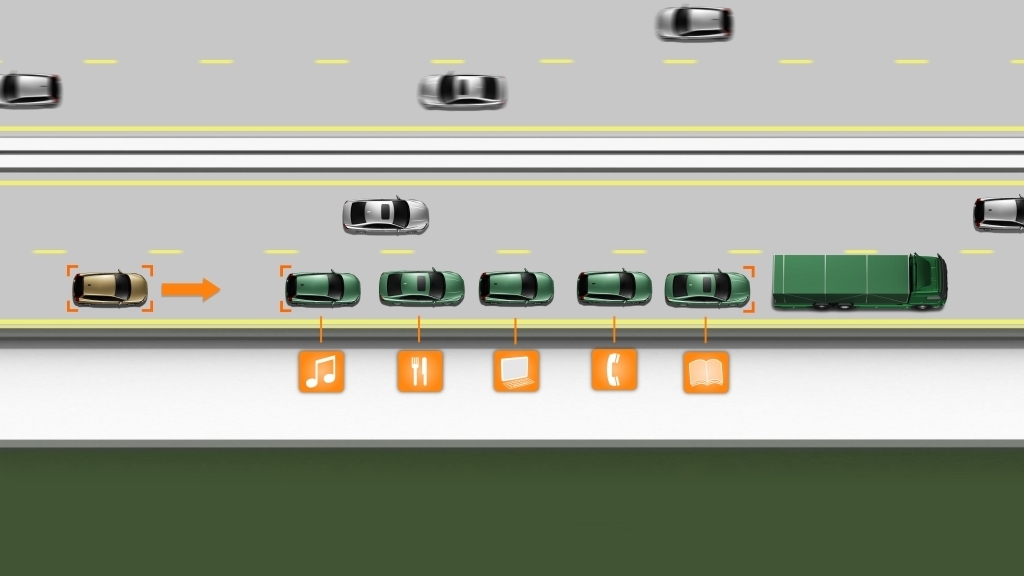Using wireless technology to link a road train, in which a lead truck controls a convoy of vehicles driving behind it, is already technically feasible.
The technology was demonstrated at the conclusion of the SARTRE project, which Volvo Trucks participated in. Although it may take some time for wireless road trains to be part of everyday reality, the technology brought about through the project could be put to use for other purposes to make our traffic environment considerably safer in the near future.
The EU-financed SA RTRE (Safe Road Trains for the Environment) project recently presented the results of three years of research and trials. Representatives from the EU Commission and experts in transport technology from Europe, the US and Japan got to see a fully functioning wireless road train in operation at Volvo's proving ground in Sweden. In the lead was a Volvo FH truck, closely followed by another Volvo truck and three cars.
RTRE (Safe Road Trains for the Environment) project recently presented the results of three years of research and trials. Representatives from the EU Commission and experts in transport technology from Europe, the US and Japan got to see a fully functioning wireless road train in operation at Volvo's proving ground in Sweden. In the lead was a Volvo FH truck, closely followed by another Volvo truck and three cars.
Self-driving cars in road trains
The participants were able to see that the project's aims had been achieved: development of a technology for wireless road trains that can improve traffic safety, reduce the environmental impact of road traffic and improve traffic flow. The building of test vehicles, car-to-car communication and sensors for the control of nearby vehicles has been underway for three years. Now these technical achievements make it possible for multiple vehicles in a road train to integrate smoothly with other traffic on public motorways. The entire road train is interconnected through wireless technology, which ensures that the trailing cars follow exactly in the track of the lead vehicle - as though the train consisted of a single vehicle. The result is that the driver in a trailing car can relax, perhaps read a book or watch TV, while the car drives itself.
"The gaps between the vehicles are much smaller than in normal traffic, but it is as safe, or even safer to be part of the road train, since it is lightning-quick computers and not human beings who respond to even the slightest change in any of the cars in the train," explained Andreas Ekfjorden, Project Manager for Volvo Trucks' portion of the SARTRE project.
One of Volvo Trucks' most important responsibility areas in the project was to determine exactly what information needs to be transmitted back down the road train so that the other cars can follow the lead truck.
"All the vehicles in the road train have a roof-mounted antenna so they can receive information from the lead vehicle's computer system. For instance, if the lead truck starts braking, all the other vehicles in the train brake at exactly the same time," said Andreas Ekfjorden.
Safer and more economical
The purpose of SARTRE - to increase safety and decrease fuel consumption - is the reason that Volvo Trucks chose to participate in the project. It is the cars' fuel consumption that drops the most as a result of the reduced air drag in the compact convoy of vehicles, but the lead truck's fuel consumption is also cut. This will make it profitable for haulage firms to provide lead trucks. Vehicles that join the convoy could pay a fee, thus benefitting the haulage firm.
"It's fantastic that a truck driver can drive from A to B with at least one car trailing behind, while at the same time cutting both fuel consumption and carbon dioxide emissions. And, not least, that he can replace several car drivers and thus boost safety," said Lennart Pilskog, director public affairs at Volvo Trucks.
Future challenges remain
However, although the SARTRE project has developed well-functioning road train prototypes there are still challenges that have to be overcome before the system can become an everyday reality. For instance, it is necessary to continue working to boost reliability, which must be on a par with that of an aircraft's autopilot before road trains can emerge as a truly viable transport solution on public roads.
Photo:SARTRE technology makes it possible for multiple vehicles in a road train to integrate smoothly with other traffic on public motorways.